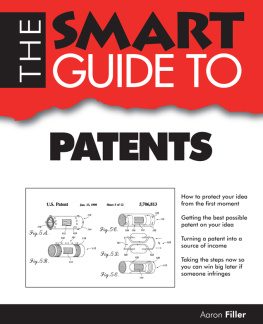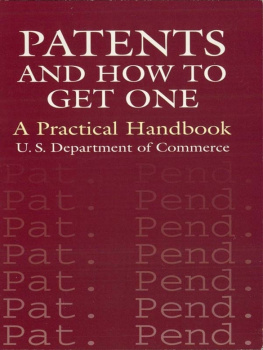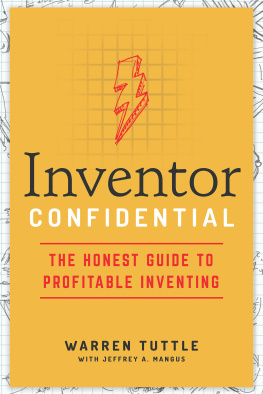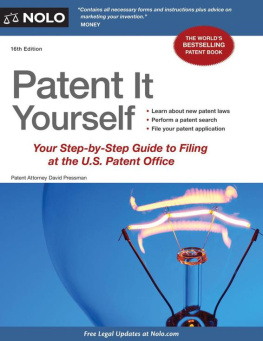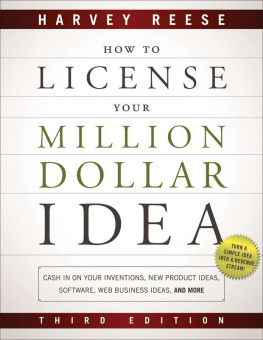THE
Independent InventorS Handbook
THE
Independent Inventors Handbook
BY
Louis J. Foreman
AND
Jill Gilbert


Copyright 2009 Louis J. Foreman and Jill Gilbert Welytok
All rights reserved. No portion of this book may be reproducedmechanically, electronically, or by any other means, including photocopyingwithout written permission of the publisher.
The trademarks and logos referred to in this book are examples, and they are each the property of their respective owners.
This book references websites that may be of interest to the reader. Every effort has been made to ensure that the information about these resources is correct and up to date as of press time.
Library of Congress Cataloging-in-Publication Data is available.
eISBN 9781523507689
Workman Publishing Company, Inc.
225 Varick Street
New York, NY 10014
www.workman.com
INTRODUCTION
The Entrepreneur & the Attorney
From the Entrepreneur
Everybody has a great idea, and that great idea has the potential to change the way we live, the way we work, or the way we play. The problem is that most people never follow through on making their idea a marketable reality. It could be that you dont have the financial resourceswhat, youre not willing to take out a second mortgage on the house or risk your kids college tuition to pursue an idea? Maybe you dont want to leave your day jobyouve got a great one and leaving it to pursue your invention is too big a risk. Or perhaps you dont completely understand the process of having an idea and making money from it.
So how, exactly, does the average person transform a mere sketch on a napkin into a useful product and make it available to the masses? Single mother and secretary Bette Nesmith Graham did it when she turned her 1956 idea of mistake out (now known as Liquid Paper or white out) into a million-dollar business by 1967. And seventeen-year-old Chester Greenwood went from grammar-school dropout to millionaire godfather of earmuffs. Band-Aids, Frisbees, zippers, the Scrabble board game, steam irons, Lifesavers candies, online bookstores, and bagless vacuum cleanersthese are all examples of massively successful patented products that started as humble but brilliant ideas. And the list of United States patents is more than 7 million strong.
So whats the secret? The plain answer is: There isnt one, but these inventions are linked by the fact that they began as unique ideas, they served (or continue to serve) an identified consumer want, and they target a specific and ready market. These ideas were also tirelessly championed by their parentsthe inventors who created them. Jeff Bezos, founder of Amazon.com, told me the story of how he borrowed a pickup truck to drive across country and start his online bookstore because he didnt want to be sitting back when he was eighty years old wondering what his life would be like if he had actually pursued an entrepreneurial dream. Most regrets are acts of omission rather than commission, he says; so he just did it. I recently met James Dyson, whose story began with a prototype for a bagless vacuum cleaner crafted from cereal boxes and duct tape and continues, 5,127 prototypes later, with the number one selling vacuum cleaner in the world and more than $1 billion in sales.
But enough about their stories, because, as inspiring as they are, this book is really about yours.
For whatever reason, the vast majority of great ideas never surface. And Jill, my coauthor, and I would like to change that. Weve set out to provide you with all the tools you need to educate yourself about the invention development process. Weve paired these lessons with examples of individual inventors who have done it before, so you know its possible for youyes, youto turn your idea into a successful, marketable product.
I like to think of pursuing an invention or entrepreneurial endeavor as a journey. Like a traveler planning a trip, you need to know how much its going to cost to get to your destination before you start driving. Many times I see inventors and entrepreneurs who are so excited about the prospect of making a fortune from their idea that they forget about what its going to take to get there. They forget to gas up. Or they plan for only one fill-up along the way. Going forward with an idea without a plan for paying the costs of bringing your invention to the market is the biggest mistake you can make; and its often what stalls people. Making money off a great idea requires incredible patience and an investment of time and financial resourcesall topped off with a bit of luck.
My own entrepreneurial journey started as a child: I was always coming up with creative ways to make money, whether it was running a backyard carnival or selling greeting cards door to door. By the time I reached college, my mothers dream of my becoming a doctor was well off course (the C in organic chemistry should have been a clue). During my sophomore year, I started running a small T-shirt company out of my fraternity room. A few short years later, it had grown into one of the largest screen-printing and embroidery companies in the United States, with more than 150 employees and nearly 80,000 square feet of manufacturing space.
I sold that company in 1995 and moved to Charlotte, North Carolina, to pursue another business opportunity: starting a NASCAR apparel company called Track Gear. Fortuitously, Track Gear went from zero in revenue to over $15 million in sales in less than two years; I sold that business to a publicly traded company in 1997.
A little more than ten years out of college, having become a bit of a serial inventor, I reached a goal that many entrepreneurs hope to achieve: With five successful startups under my belt, I had set myself up for early retirement. But that entrepreneurial spirit just wouldnt go away, and I realized very quickly that I wanted to keep working in business, only now with the intent of helping others do what I did.
Ive spent the last decade mentoring hopeful inventors and entrepreneurs and holding small-business seminars for groups at community colleges. Its exciting to sit with a group of aspiring entrepreneurs and offer advicesometimes providing people the inspiration to move forward and sometimes offering a healthy dose of reality to help them understand that the timing isnt always right and reassessment may be in order. And I founded Enventys, a unique industrial-design and marketing firm that helps develop and launch products for top companies in the United States.
The dot-com decade spawned a stellar lot of billionaires, but my journey wasnt built on computer coding or visions of technology. My own products and inventions have always been about people and how we live our everyday lives. I work with what I knowmany of my inventions and companies have been related to serving just about every sport for which Im a spectator or participant, including a line of NASCAR clothing and a high-performing soccer shin guard. My vision is not about computer screens; rather, its about the evolving consumer marketthat beating pulse of our culture and economy.
Over the years, I came to realize that as exciting to me as these one-on-one mentoring conversations and talks to an audience of thirty to fifty people were, there is a vast number of people out there who would never hear the words I was speaking. So when the opportunity came for me and my company, Enventys, to be involved in the development of the PBS television program
Next page


